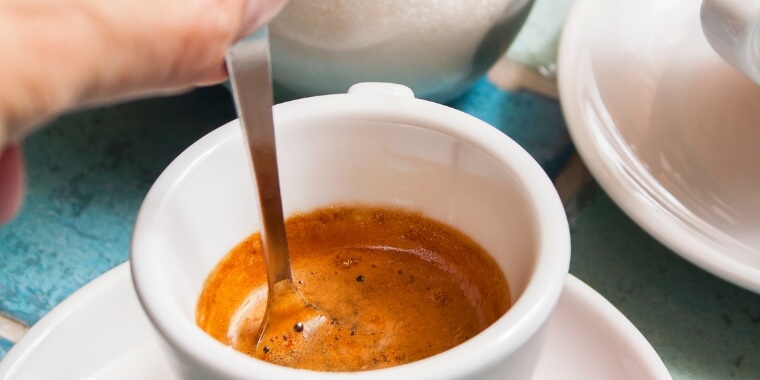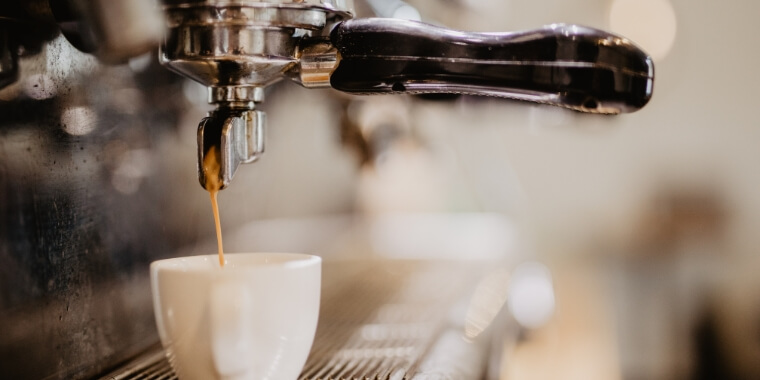If you ever wondered why are your espresso shots sour I’ve got you covered.
In this article, I’ll explore why espresso can taste sour, and what you can do to get the perfect balance of flavors in your next shot.
Why Does My Espresso Taste Sour?

If you are wondering what causes espresso to be sour there are a few key reasons:
Issue 1: Over-extraction
Have you ever tasted a shot of espresso that made your face pucker like a lemon? Well, that’s what we call over-extraction.
It’s when too much flavor is sucked out of the coffee grounds, leaving you with a bitter and sometimes astringent taste.
But wait, there’s more! Over-extraction can also make your espresso taste sour. Yuck! This happens when undesirable compounds, like chlorogenic acid, get extracted and mess up the flavor.
BTW if you are curious you can read more on how over-extraction influences coffee taste in Min-Sun Kim’s research
Issue 2: Under-extraction
Have ever tasted a shot of espresso that’s as weak as a small kitten? We’re talking about a shot that’s so weak and sour, it’ll make you wish you’d never tasted it.
Under-extraction occurs when not enough flavor is extracted from the coffee grounds, resulting in a shot that is weak and sometimes sour.
When espresso is under-extracted, it can cause the extraction of undesirable compounds, which can lead to sourness in the shot. It can also taste thin, weak, or watery, lacking the richness and body that a properly extracted shot provides.
Issue 3: Beans Quality
Poor-quality beans are the coffee beans that got rejected by the cool kids club.
They may not be roasted or stored correctly, resulting in stale or rancid beans that have lost their natural sweetness and developed unpleasant flavors.
And you know what that means? Sourness, baby!
It’s like biting into a lemon wedge without the sugar to balance it out.
And it gets worse, folks! These poor-quality beans may not even be of consistent size and quality, leading to uneven extraction.
It’s like playing Russian roulette with your espresso shots – you never know if it’s going to be too sour or too bitter. It’s like a bad episode of your favorite series, only with coffee.
Issue 4: Over-roasted beans
Over-roasting coffee beans is like trying to make toast with a flamethrower – it’s not going to end well, my friend.
The high heat used during the roasting process can break down the natural sugars in the coffee, and do you know what that means?
Say it with me now – sourness!
It’s like the coffee equivalent of a bad breakup – it masks the sweetness and leaves a sour or bitter taste in your mouth.
Issue 5: Poor grind
The grind has to be just right, or else you’ll end up with a sour shot of espresso that’ll make you cringe like a lemon.
If the grind is too coarse, the water will flow through the coffee like Usain Bolt, resulting in an under-extracted shot. It’s like a coffee shot that’s only halfway there – what’s the point?
On the other hand, if the grind is too fine, the water will flow through the coffee like a snail, resulting in an over-extracted shot. It’s like trying to suck a golf ball through a garden hose – it’s just not happening.
And if that’s not enough, inconsistent grind size can cause uneven extraction, leading to inconsistent flavor and a sour taste in some shots.
Issue 6: Dirty machine/equipment
Dirty equipment is like a bad roommate who never does the dishes – it’s going to ruin everything.
When espresso machines and grinders are not cleaned regularly or properly, coffee oils and residues can build up like a miniature oil spill and affect the taste of your precious espresso.
For example, the presence of old coffee oils in the espresso machine’s group head or portafilter can lead to rancid flavors that’ll make you wish you never got out of bed. It’s like drinking expired milk with your cereal – you just know it’s going to be sour.
Similarly, a dirty grinder is like a mischievous elf that messes with the consistency of your coffee grounds, contributing to uneven extraction and a sour taste in some shots.
Issue 7: Wrong pH balance in the water
Why is my espresso acidic? Turns out, imbalanced pH water can contribute to an acidic taste in espresso.
It’s like a science experiment gone wrong – who knew that water could affect the taste of coffee so much?
Water with a high pH level (alkaline) can make your coffee taste sour or sour-acidic. On the other hand, water with a low pH level (acidic) can lead to a bitter taste, like a cup of coffee that’s been steeped in burnt rubber.
This is because the acidity level of the coffee interacts with the pH level of the water during extraction, like a dance-off between two bitter rivals.
So, to avoid a sour taste in espresso due to imbalanced pH water, according to Seven Miles you need to use water that is within the ideal pH range of 7 to 8.5.
Summary
If you are wondering why espresso tastes sour then you should know that sour espresso can result from various issues, including over-extraction, under-extraction, poor-quality or over-roasted beans, poor grind, dirty equipment, and imbalanced pH water.
Proper extraction is also important to ensure a balanced flavor profile. By paying attention to these factors, you can achieve a rich, full-bodied, and enjoyable espresso shot.
How To Fix Sour Espresso? (7 Actionable Steps)

Here’s a step-by-step guide I am using on a regular basis that helps me to fix sour espresso:
Fix 1: Go through extraction checkpoints
Want to know how to fix acidic espresso quickly? You better break out your mad scientist lab coat because it’s all about precision.
You need to grind those beans fine enough to extract the perfect balance of flavor and make sure the water temperature and pressure are just right. It’s like a high-stakes experiment, but instead of blowing up the lab, you might just end up with a disappointing cup of joe.
And don’t forget about the length of the shot. You need to hit that sweet spot of 25 seconds (that’s the perfect extraction time according to Instituto Espresso Italiano), or risk being left with a sad, under-extracted shot that’s sourer than a bag of fizzy Haribos. So pay attention – your taste buds are depending on it!
Fix 2: Check your water temperature
It’s time to get hot and steamy – with your water temperature, that is. If your water is too cold, you might as well be trying to extract espresso with ice cubes. That’s a one-way ticket to sour town, and nobody wants to go there.
According to the folks at the Speciality Coffee Association, you want to aim for a temperature between 197 – 205°F (that’s 92 – 96°C for all you metric system enthusiasts out there).
So don’t be a temperature tease – get that water temperature dialed in and you’ll be one step closer to espresso bliss.
Fix 3: Adjust your grind size
It’s not you, it’s your grind size!
If your grind size is too coarse, the water will flow through the coffee too quickly and leave you with an under-extracted shot, resulting in sourness.
That’s not what we want, so try adjusting your grind to be finer to slow down the flow rate of water through the coffee.
A finer grind will help extract more flavor and reduce sourness.
And if you want to avoid a sour taste in your espresso due to poor grind, invest in a high-quality grinder and make sure your grind is consistent and suitable for your brewing method.
Fix 4: Use high-quality, fresh beans
Poor-quality beans can ruin your espresso experience and leave you with a sour taste in your mouth.
Don’t worry though, you don’t have to be a coffee snob to avoid this! Just use high-quality, fresh beans that have been roasted and stored with love and care.
Fix 5: Clean your equipment
If you want to avoid a sour taste in your cup, make sure to clean your equipment regularly and properly.
And by “clean,” I don’t mean just a quick wipe with a napkin. I’m talking about backflushing your machine, scrubbing your group head and portafilter, and even polishing your grinder.
Your equipment deserves some love too, and keeping it clean will ensure a delicious and enjoyable flavor in your espresso shot.
Fix 6: Use water with the ideal pH range
That’s right, imbalanced pH water can turn your perfect shot into a sour disaster. So, make sure to use water within the ideal pH range of 7 to 8.5 to avoid this coffee catastrophe.
Fix 7: Use different ratios
Don’t be afraid to shake things up!
While a 1:2 ratio is often recommended as the essential espresso recipe, it’s not always the best solution. Instead, try stretching the ratio a bit more (1:2.5 to 1:3), and you’ll extract more sweetness from the bean while also diluting the shot a bit.
It’s like adding a little water to your whiskey – it opens up the flavors and makes it more enjoyable.
Summary
This actionable guide offers seven fixes to help you fix sour espresso. Go through extraction checkpoints, water temperature, and grind size, use high-quality, fresh beans, clean your equipment, and use water with the ideal pH range.
By following these steps, you can achieve a balanced flavor in your espresso shot.
BTW What Does Sour Espresso Mean?

Cambridge dictionary defines sour as “having a sharp, sometimes unpleasant, taste or smell, like a lemon”.
From my perspective, sour espresso is like a punch in the gut. It’s a sign that something’s gone awry in the delicate dance of espresso extraction.
It’s like trying to do the tango and your partner suddenly starts breakdancing – it’s just not gonna work.
My Final Thoughts
Why is espresso sour? It could be due to over-extraction, under-extraction, poor-quality beans, or even dirty equipment.
But fear not, apply the actionable steps to fix your sour espresso and the next one should taste much better.
Remember, a sour espresso is like a dance gone wrong, but with these steps, you can bring harmony back to your taste buds.

